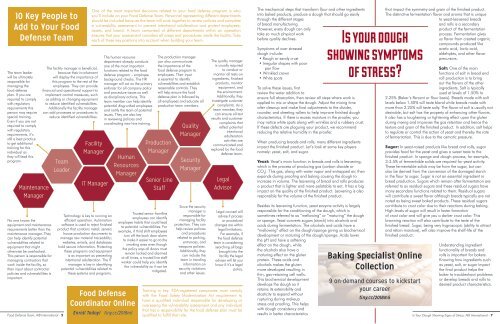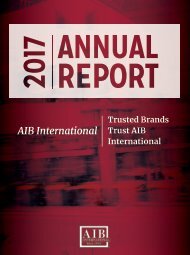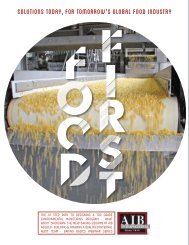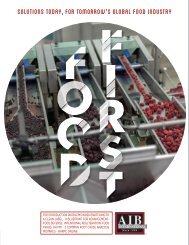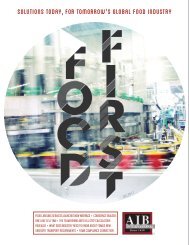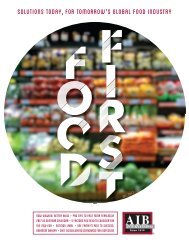You also want an ePaper? Increase the reach of your titles
YUMPU automatically turns print PDFs into web optimized ePapers that Google loves.
10 Key People to<br />
Add to Your Food<br />
Defense Team<br />
The team leader<br />
will be ultimately<br />
responsible for<br />
managing the<br />
food defense<br />
plan. If you are<br />
required to comply<br />
with regulatory<br />
requirements this<br />
person may require<br />
special training.<br />
Even if you are not<br />
required to comply<br />
with regulatory<br />
requirements, it’s<br />
still a best practice<br />
to get additional<br />
training for this<br />
individual as<br />
they will lead this<br />
program.<br />
Maintenance<br />
Manager<br />
No one knows the<br />
equipment and maintenance<br />
requirements better than the<br />
maintenance manager. They<br />
can help identify potential<br />
vulnerabilities related to<br />
equipment that might<br />
otherwise be overlooked.<br />
This person is responsible for<br />
managing contractors that<br />
work inside the facility, so<br />
their input about contractor<br />
policies and vulnerabilities is<br />
important.<br />
The facility manager is beneficial,<br />
because their involvement<br />
will display the importance of<br />
this program to the rest of the<br />
employees. They can provide<br />
financial and operational support to<br />
implement control measures, such<br />
as adding or changing equipment<br />
to reduce identified vulnerabilities.<br />
Additionally the facility manager<br />
can add processes or procedures to<br />
reduce identified vulnerabilities.<br />
Team<br />
Leader<br />
Food Defense Team, <strong>AIB</strong> International - 2<br />
One of the most important decisions related to your food defense program is who<br />
you’ll include on your Food Defense Team. Personnel representing different departments<br />
should be included because the team will work together to review policies and complete<br />
a vulnerability assessment to prevent intentional adulteration and protect employees,<br />
assets, and brand. A team comprised of different departments within an operation<br />
ensures that your assessment considers all areas and procedures inside the facility. Take<br />
each of these key positions into account when building your team.<br />
Facility<br />
Manager<br />
IT Manager<br />
Technology is key to running an<br />
efficient operation. Automation<br />
software is used to reject finished<br />
product that contains metal; servers<br />
house production documents to<br />
manage raw material traceability;<br />
websites, emails, and databases<br />
hold secure information. Protecting<br />
these programs and equipment<br />
is as important as preventing<br />
intentional adulteration. The IT<br />
manager is key in identifying<br />
potential vulnerabilities related to<br />
these systems and programs.<br />
The human resource<br />
department already conducts<br />
one of the most important<br />
functions related to the food<br />
defense program – employee<br />
background checks. The HR<br />
manager will act as the primary<br />
enforcer for all company policy<br />
and procedure issues as well<br />
as disciplinary actions. This<br />
team member can help identify<br />
potential disgruntled employees<br />
and notify the team of potential<br />
issues. They are also key<br />
in reviewing policies and<br />
coordinating new hire training.<br />
Human<br />
Resources<br />
Manager<br />
Food Defense<br />
Coordinator Online<br />
Enroll Today! tiny.cc/<strong>2018</strong>m1<br />
Trusted senior frontline<br />
employees can identify<br />
employee habits that could lead<br />
to potential vulnerabilities. For<br />
example, if third shift employees<br />
turn off the back door alarm<br />
to make it easier to go to the<br />
smoking area even though<br />
the policy says all doors must<br />
remain locked and alarmed<br />
at all times, a trusted line staff<br />
worker could help you identify<br />
the vulnerability so it can be<br />
mitigated.<br />
The production manager<br />
can also communicate<br />
the importance of the<br />
food defense program to<br />
employees. Their input<br />
is essential to identify<br />
vulnerabilities and establish<br />
reasonable controls. They<br />
will help ensure the food<br />
defense plan is followed by<br />
all employees and educate all<br />
production team members.<br />
Production<br />
Manager<br />
Senior Line<br />
Staff<br />
Quality<br />
Manager<br />
Security<br />
Manager<br />
Since the security<br />
manager is<br />
responsible for<br />
managing facility<br />
protection. They can<br />
help review policies<br />
and procedures<br />
related to parking,<br />
entrances, and<br />
weapons policies.<br />
Additionally, they<br />
can include the<br />
team in trending<br />
information on<br />
security violations<br />
and other issues.<br />
The quality manager<br />
is usually required<br />
to conduct or<br />
monitor all tests on<br />
ingredients, finished<br />
products, monitor<br />
equipment, and<br />
the environment.<br />
Additionally, they<br />
investigate customer<br />
complaints. As a<br />
team member, they<br />
can ensure all test<br />
results and customer<br />
complaints that<br />
reflect potential<br />
intentional<br />
adulteration<br />
activities are<br />
communicated and<br />
explored by the food<br />
defense team.<br />
Legal<br />
Advisor<br />
Legal counsel will<br />
advise if process<br />
or procedural<br />
changes are within<br />
legal limitations.<br />
For example, if<br />
the food defense<br />
team is considering<br />
searching all bags<br />
brought into the<br />
facility the legal<br />
adviser will let you<br />
know if it’s a legal<br />
policy.<br />
Training is key. FDA-registered companies must comply<br />
with the Food Safety Modernization Act requirement to<br />
have a qualified individual responsible for developing or<br />
overseeing the vulnerability assessment and any individual<br />
that has a responsibility for the food defense plan must be<br />
qualified to fulfill that role.<br />
The mechanical steps that transform flour and other ingredients<br />
into baked products, produce a dough that should go easily<br />
through the different stages<br />
of bread manufacturing.<br />
However, every dough can only<br />
take so much physical work<br />
before quality declines.<br />
Symptoms of over stressed<br />
dough include:<br />
• Rough or sandy crust<br />
• Irregular shapes with poor<br />
pan flow<br />
• Wrinkled crown<br />
• White spots<br />
To solve these issues, first<br />
review the water addition to<br />
ensure full absorption, then review all steps where work is<br />
applied to mix or shape the dough. Adjust the mixing time<br />
after cleanup and make final adjustments to the divider,<br />
rounder, and sheeting rollers to help improve finished dough<br />
characteristics. If there is excess moisture in the proofer, you<br />
may notice white spots along with wrinkles and a rubbery crust.<br />
If these defects are plaguing your product, we recommend<br />
reducing the relative humidity in the proofer.<br />
When producing breads and rolls, many different ingredients<br />
impact the finished product. Let’s look at some key players<br />
namely: yeast, salt, and sugar.<br />
Yeast: Yeast’s main function in breads and rolls is leavening,<br />
which is the process of producing gas (carbon dioxide or<br />
CO 2<br />
). This gas, along with water vapor and entrapped air, then<br />
expands during proofing and baking causing the dough to<br />
increase in volume. The leavening of bread and rolls produces<br />
a product that is lighter and more palatable to eat. It has a big<br />
impact on the quality of the finished product. Leavening is also<br />
responsible for the volume of the finished product.<br />
Besides its leavening function, yeast enzyme activity is largely<br />
responsible for the conditioning of the dough, which is<br />
sometimes referred to as “mellowing” or “maturing” the dough<br />
or sponge. Yeast converts sugars (starch) into alcohols and<br />
acids during fermentation. The alcohols and acids have a<br />
“mellowing” effect on the dough/sponge giving us biochemical<br />
development or maturing of the dough/sponge. Acids lower<br />
the pH and have a softening<br />
effect on the dough, while<br />
the alcohols also have a<br />
maturing effect on the gluten<br />
protein. These acids and<br />
alcohols makes the gluten<br />
more developed resulting in<br />
thin, gas-retaining cell walls.<br />
This biochemical development<br />
develops the dough so it<br />
retains its extensibility and<br />
elasticity to expand without<br />
rupturing during makeup<br />
stress and proofing. This helps<br />
with dough consistency and<br />
results in better characteristics<br />
Is your dough<br />
showing symptoms<br />
of stress?<br />
Baking Specialist Online<br />
Collection<br />
9 on-demand courses to kickstart<br />
your career<br />
tiny.cc/<strong>2018</strong>m5<br />
that impact the symmetry and grain of the finished product.<br />
The distinctive fermentation flavor and aroma that is unique<br />
to yeast-leavened breads<br />
and rolls is a secondary<br />
product of the fermentation<br />
process. Fermentation gives<br />
us flavor from created organic<br />
compounds produced like<br />
acetic acid, lactic acid,<br />
aldehydes, and other flavor<br />
precursors.<br />
Salt: One of the main<br />
functions of salt in bread and<br />
roll production is to bring<br />
out the flavors of the other<br />
ingredients. Salt is typically<br />
used at levels of 1.50% to<br />
2.25% (Baker’s Percent or flour basis). Breads made with salt<br />
levels below 1.50% will taste bland while breads made with<br />
more than 2.25% will taste salty. The flavor of salt is usually not<br />
desirable, but salt has the property of enhancing other flavors.<br />
It also has a toughening or tightening effect upon the gluten<br />
during mixing and improves the gas retention and hence the<br />
texture and grain of the finished product. In addition, salt helps<br />
to regulate or control the action of yeast and thereby the rate<br />
of fermentation. This is due to the osmotic pressure.<br />
Sugar: In yeast-raised products like bread and rolls, sugar<br />
provides food for the yeast and gives a sweet taste to the<br />
finished product. In sponge and dough process, for example,<br />
3-3.5% of fermentable solids are required for yeast activity.<br />
These fermentable solids may be from the sugar, but can<br />
also be derived from the conversion of the damaged starch<br />
in the flour to sugar. Sugar is not an essential ingredient in<br />
bread production. Sugars which remain after fermentation are<br />
referred to as residual sugars and these residual sugars have<br />
many secondary functions related to them. Residual sugars<br />
will contribute a sweet flavor although breads typically are not<br />
noted as being sweet baked products. These residual sugars<br />
contribute to crust color due to their reactions during baking.<br />
High levels of sugar will result in faster formation<br />
of crust color and will give you a darker crust color. This<br />
browning reaction will also contribute to the taste of the<br />
finished bread. Sugar, being very hygroscopic (ability to attract<br />
and retain moisture), will also improve the shelf-life of the<br />
finished product.<br />
Understanding ingredient<br />
functionality of breads and<br />
rolls is important for bakers.<br />
Knowing how ingredients such<br />
as yeast, salt, or sugar impact<br />
the final product helps the<br />
baker to troubleshoot problems<br />
or develop breads and rolls to<br />
desired product characteristics.<br />
Is Your Dough Showing Signs of Stress, <strong>AIB</strong> International - 7


